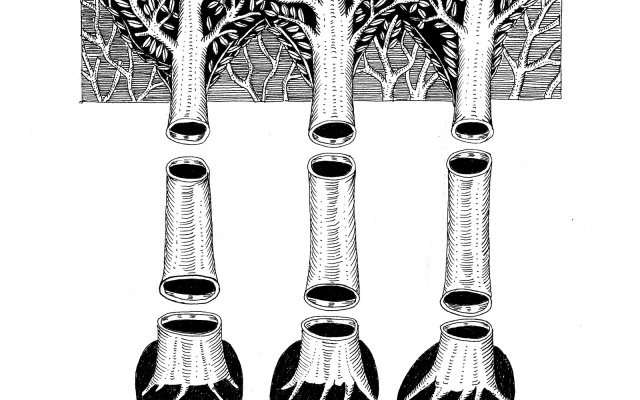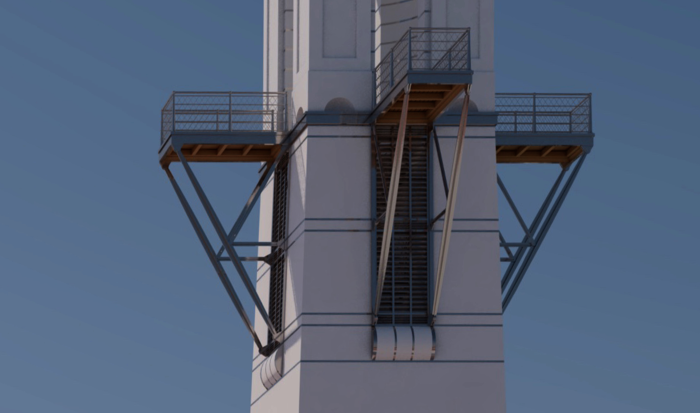
M.M: At which point had architecture come to a standstill and how is it possible that the modern movement has so violently taken positions in the university departments and practices around the world?
LK: Firstly, the now commonly used expression « Modern Movement » needs to be corrected to « Modernist Movement ». I keep repeating this because modernist propaganda dominates via the fraudulent appropriation of the term “modern”, claiming that theirs is the only legitimate form of modernity in art and architecture. They arrogate universality for a purely sectarian view. They equal this view with progress and imply erroneously that to practice traditional art and architecture today is backward and hence anachronistic. The claim is factually erroneous, ideological, intolerant and undemocratic, it expropriates the general public, clients, students and professionals, of their individual ability and right to judge and choose. It dominates architectural practice, education and media and is uniquely responsible for a generalized architectural illiteracy and with it, for the debased built environment of today.
Secondly. The dominance of modernism after WWII results from its tight alliance with dominant economic and political forces. The collusion of hyper scaled global industries, finance and state, was enforced at the cost of small scale independent local enterprises. In short, industrial machine-scale production triumphed over craft based human-scale production with the active help of state institutions. Architects, their ethics and aesthetics had to serve the new masters or be condemned to the margins of events and society. Post war modernist urban developments and reconstructions continued carpet-bombing by other means, resulting in the conceptual and physical elimination of the traditional European City, of urban communities and city life itself. It also meant the eradication from architecture and urbanism disciplines of what had survived of architectural literacy, of artisan and artistic know-how, of human scale building and planning culture, in all pre-war regimes independent of political ideology. The generalized application of the Athens Charter principles enforced by law the dismemberment and dispersal of the traditional urban fabric. Thus the victory of machine over human scale, of industrial over craft aesthetics, of global over local enterprise were secured. Modernism and kitsch, suburbia and motopia reign supreme since 1945.
M.M: Initially, you worked with the most prominent British architect who became a kind of a nexus in the branching of different types of the modern movement. Which experiences have you carried with you from this practice? Were your beginnings with Stirling what gave you interest and understanding of architecture which cannot be perceived in other practices that today cultivate the classical language of architecture?
LK: When I joined 75 Gloucester Place in July 1968, Stirling was in a profound crisis. His career had peaked with the Leicester Engineering Faculty. The History Library Building in Cambridge didn’t fulfil what the famous axonometric projection had promised and the Oxford Florey building, for which I detailed the elaborate tiling skin, was an unqualified failure. Because of his personal crisis he left different people in the office a degree of freedom in defining designs. He would pick and choose amongst alternatives and comment. In the 4 years I worked on and off with him he didn’t draw or doodle. This was particularly troubling for me because I desperately longed to find a master. By the time I edited his first Oeuvre Complète book in 1973, he had even thrown away thick folders of intense thumb nail sketches I had discovered years before in bottom drawers.
I learned from Stirling how to make convincing presentation drawings, what view to frame. He had a loupe which, instead of enlarging, reduced a drawing as it would appear in print, signalling where to thicken, thin or dot a line, with the view to produce an iconic image. When I asked his opinion about Paul Rudolph’s recently published drawings, he sighed “…too many lines”. My free time was mostly spent at the RIBA library. It is there that I freed myself from a critical Le Corbusier addiction and discovered a wide world of modern architectures: Otto Wagner, Wagnerschule, Friedrich Pindt, Rudolf Perco, Rudolf Weiss, Joze Plecnik, Wunibald Deininger, Virgilio Marchi, Mario Chiattone, Antonio Sant’ Elia, Marcello Piacentini, Angiolo Mazzoni, Giancarlo Maroni, Paul Schmitthenner, Heinrich Tessenow, Roderich Fick, Armando Brasini, Adalberto Libera, Paul Ludwig Troost, Albert Speer, Adolphe Appia, Aage Rafn, Kaare Klint, Ivar Bentsen, Edvard Thomsen, Hannes Mayer & Hans Wittwer, Carl Gruber, Giuseppe Pettazzi, Jaromir Krejcar, Otto Zollinger.
M.M: Was there, at least in the beginning, a way for modernism to be structured in a classical sense and what kind of results would such an approach offer? In his books, Le Corbusier mentions Bach and Satie, and the hereditary line of history, even the tradition that he is trying to follow, and the proportion in architecture is his most recognizable feature.
LK: Modernism in its early stages could be understood as a liberation from a pervasive Victorian stuffiness and profligacy. Indeed the small highly individual projects of early modernist masters promised a new world of comfort, light and elegance. None of those qualities survived in the cloned abstractions of mass-production and sub-urbanism which followed. Le Corbusier had written about a possible “Synthèse des Arts”. His works instead manifested a systematic “Confusion des Arts”, garbling the happily established categories of Art, Sculpture, Music, Architecture, Urbanism. Stirling had no such overall goal for the built environment, hopping from experiment to experiment, never engaging in theoretical debates, at least not with assistants. It was precisely because of his direction-less-ness that I felt an imperative need to build a modern general theory of architecture and urbanism, of what an architect’s work, efforts and ideas had to add up to. Stirling’s excursions into the realm of synthetic materials and techniques did not exclude a passing interest in traditional forms and classicism Those themes were for him mere temporary sandboxes games. When he saw my bird’s eye view for the completion of a medieval town, displaying traditional roofs, windows, arches and columns he interjected “OK, but I would never dare go that far”. When I reminded him that he had, with his 1955, Team X, Aix-les-Bains contribution, done just that, he shrugged shoulders, ”Oh that, but the Smithson’s didn’t like it” as if that could be anyone’s concern! For me his 1955 Sheffield University competition and Leicester Engineering Faculty of 1959, were exceptional and foundational works on which to build a theory, allying these brilliant typological experiments with classical composition. I kept repeating this over years but he wouldn’t engage.
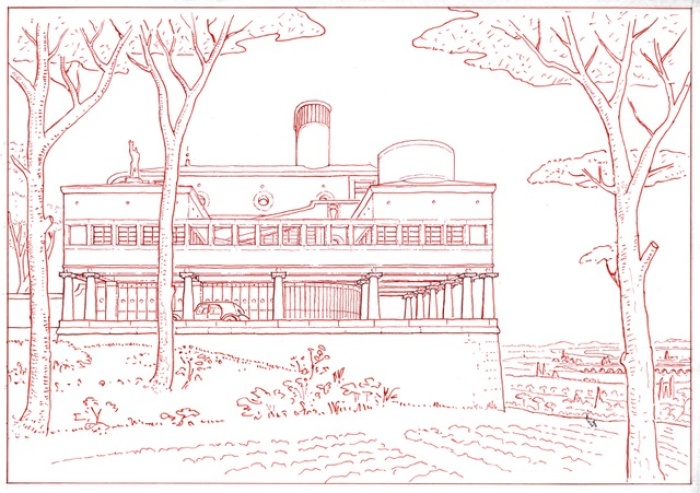
Savoye LC LK 2018. Przekład projektu dla willi savoye jest częścią nowej książki Leona Kriera “le corbusier after le corbusier”: LC przetłumaczony, poprawiony, zakończony. Będzie stanowić zwieńczenie ośmiotomowego wydania dzieł zebranych w postaci tomu dziewiątego.
M.M: Which are the last exemplary cases of well-designed cities and buildings on the European soil in your opinion?
L.K: There are plenty of new traditional urban and architectural projects under construction around Europe and the Americas. They are like the Prince of Wales Poundbury project entirely undertaken by private initiative. Val d’Europe, Plessis-Robinson, Brandevoort, Lomas de Marbella Club, Pont Royal-en-Provence, Knokke-Heulebrug, Windsor and Alys Beach in Florida, Paseo Cayala in Guatemala. In contrast contemporary modernist developments, however large or “advanced” like the Apple, Facebook, Google, Masdar mega-compounds are, without exception, of a suburban nature, horizontal or vertical mono-thematic and suburban sprawl.
We are the first generation to have reacted against the cataclysmic modernist devastation of the World by building an operative critique backed by a general theory for a human-scale architecture and urbanism. This model of new traditional architecture and urbanism is being applied worldwide. I had the lucky misfortune to grow up in cities which had been spared the war-destructions yet already suffered the tragic consequences of modernist redevelopment policies. The traditional European City was being deconstructed as social, physical economic structure, as an ethical and aesthetic space. It is that model which is common to all European nations. It had allowed the open modern society to emerge and flourish. It is that city model, inherited from Athens and Rome, which modern societies worldwide desire, but are everywhere told by modernist propaganda, that they can no longer have, except for holidays and entertainment. All the buildings of the European Union in Bruxelles, Luxembourg and Strasbourg are the negation, a nemesis of Traditional European Urbanism and Architecture. The elephantine, repulsive and shoddy E.U. buildings represent for many Europeans the unmistakable symbols of waste and corruption, of parasitical technocracy and bureaucracy. It is time for European Reformers to set a model for rebuilding Europe by founding a human scale and beautiful New European Capital. It is only such a positive vision and new foundation which could help to revert the falling apart of Europe into self-destructive atoms.
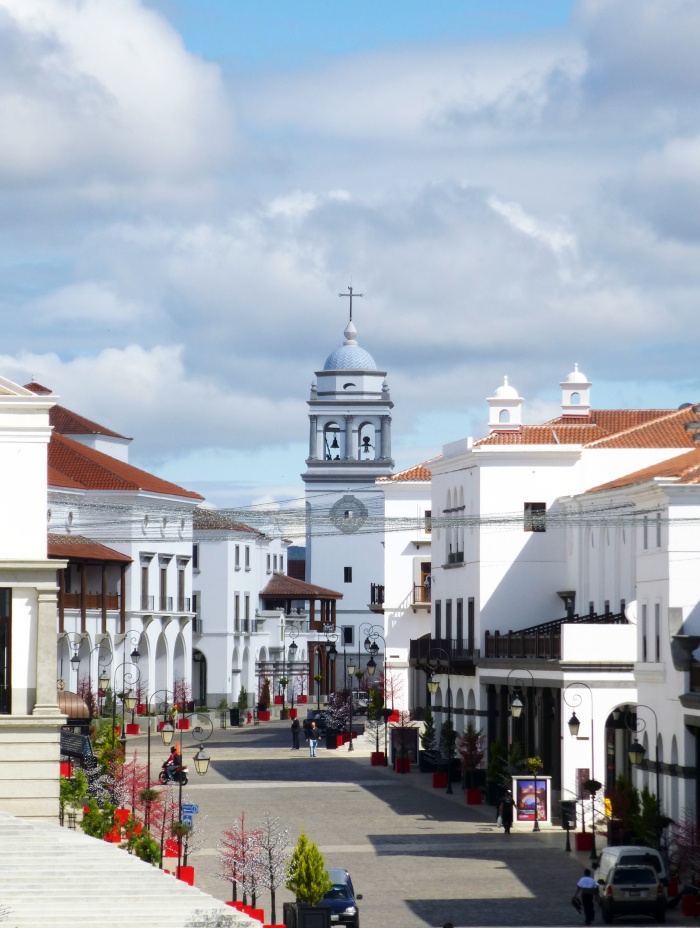
Cayala Paseo i dzwonnica przyszłej katedry. Główni architekci Estudio Urbano (Pedro Godoy i Maria Sanchez)
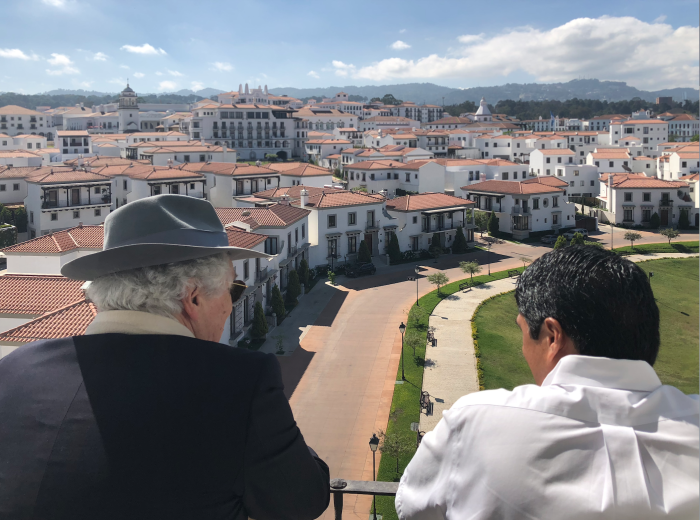
Leon Krier i Hector Leal (klient) Paseo Cayala: Plan główny 2003 Leon Krier i Estudio Urbano. Widok na bulwar Corniche w stronę dzielnicy Paseo Cayala
M.M: Jože Plečnik. A brave and quiet architect who continued to use the classical language of his profession with dignity and despite the heated tendency of modernism to break up with the previous traditions. Did he affect you, and in which way should his work be interpreted today?
L.K: I discovered the NAPORI collection of line drawings in the early 1970ies and was so moved by the book that I sent copies to friends, to Michael Graves, Walter Pichler, my brother, Stirling and observed how it affected their work. I mostly value his interventions in Prague Castle and Gardens. After a recent three days visit to Ljubljana I had more than my full measure of Plecnik, finding it all too rich for daily bread. He is an extraordinary font of invention but I judge the true importance of an architect by envisioning what if an entire city block, an entire quarter, town, region, continent, the entire world were built according to his personal philosophy and maniera. Gaudi, Plecnik, Corbusier, simply don't qualify for a pantheon occupied by the minds who built Venice, Pergamon, Dubrovnik, Dresden, Paris, Williamsburg, by Wagner, Schinkel, Persius, Palladio, Sanmicheli, Lutyens.
M.M: To what extent is the city of Poundbury, apart from being built and inhabited, a utopian project, and in the same way similar to the proposals that arose from the modern movements?
L.K: Poundbury has nothing utopian about it. It is a working traditional English town as they grew and stood for hundreds of years. After a 100 years long sub-urban hiatus, the Prince of Wales achieves to build the first coherent model of all that which modernism and sub-urbanism denied; urbanity, community, mixed use, human scale, familiarity, uniqueness, harmony, commodity, natural materials, beauty, durability. It is in Europe the first coherent and very successful countermodel to suburbia and motopia. The latter are futureless forms of settlement. The functional zoning of cities is driving the daily mobilization of the entire population in the performance of everyday tasks. This enforced geographic segregation is responsible for the catastrophically global wastage of time, land and energy of modern societies. It is profoundly unsustainable. The only way forward is to design integrated settlement policies on national and continental scales that will promote the ‘walkable city’, both with regard to walkable distances and to walkable building heights. The real ecological challenge resides then in the territorial reorganization of daily human activities within society.
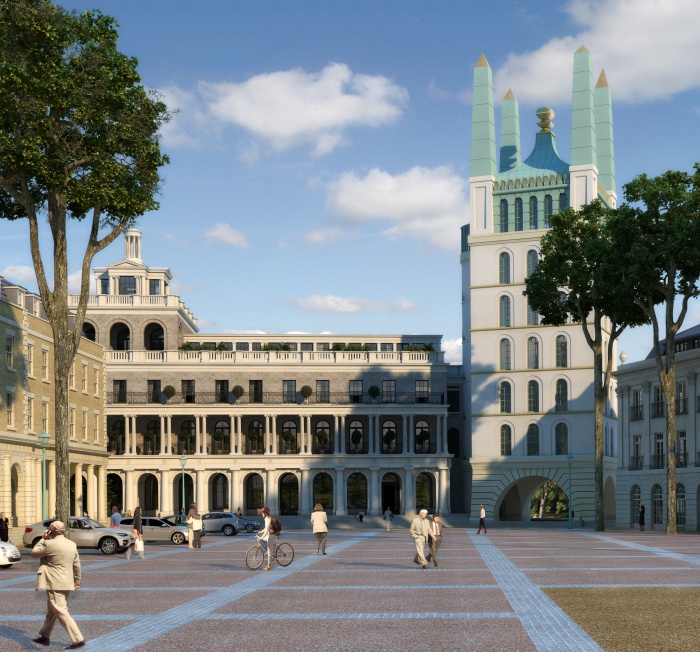
Poundbury skwer królowej matki LK 2011 architekci, cokół królowej matki: Leon Krier 2010, królewski dom punktowy i hotel księżnej Kornwalii: Quinlan i Francis Terry. Królewski pawilon i wieża: Ben Pentreath 2012-2018.
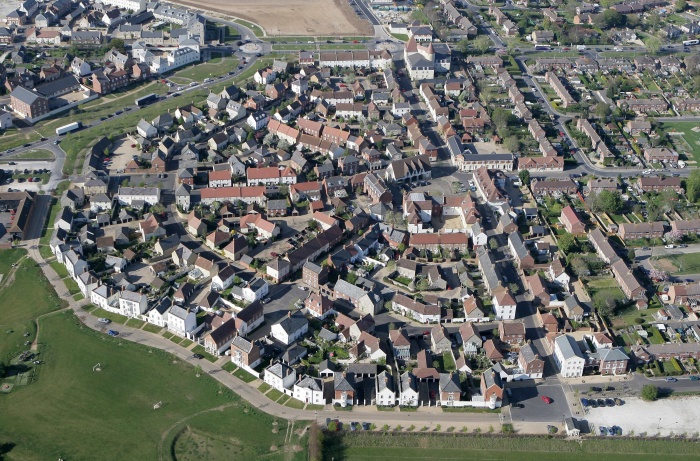
Poundbury faza I planu głównego i architektoniczna koordynacja: Leon Krier 1988-1997. Główni architekci: Peterjohn Smyth, David Oliver, David Wren, Ken Morgan, Liam O'connor.
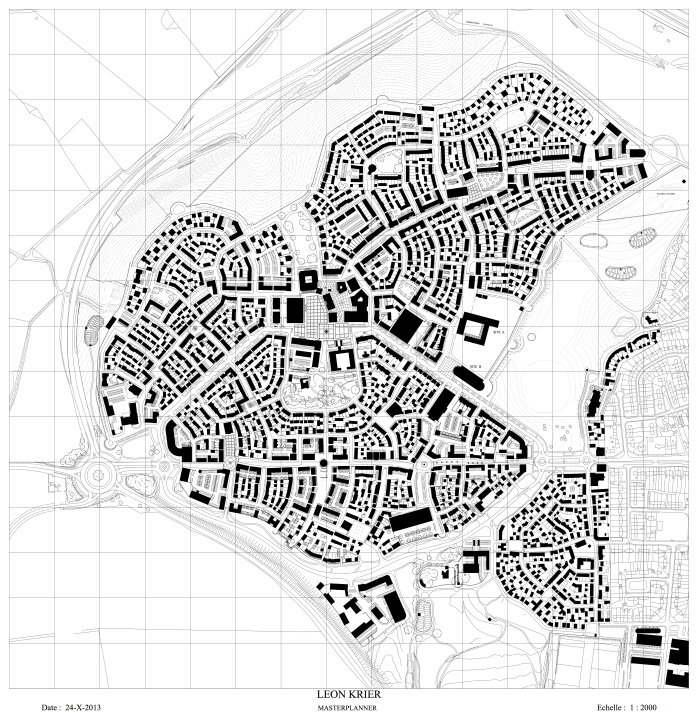
Plan główny Poundbury 2014. Plan główny dla projektu Poundbury księcia Walii datuje się na rok 1988. Budowa rozpoczęta w 1993. Obecnie na wykończeniu jest etap III. Poundbury złożone jest z 4 niezależnych dzielnic miejskich, integrujących wszystkie sfery przydatności (mieszkalne, handlowe, edukacyjne, przemysłowe, wypoczynkowe) w dzielnicach o obszarze maks. 30 hektarów. Plan główny i koordynacja: Leon Krier. Główni architekci: Ben Pentreath, George Saumarez Smith.
M.M: What needs to be done to bring the classical language of architecture and traditional construction closer to the upcoming generations. Could this possibly become the only way to rescue the world from a cataclysmic future and a necessity which will not need to be imposed at all? Today, hysteria towards antique and old is both obvious and almost boring, to what extent does this really hurt or help with having a serious approach towards the shaping of cities, and who, in your opinion, behaves best as a traditionalist today?
L.K: What needs to be done before all else is to close all architecture, urban planning and engineering schools and institutes that refuse to teach or recognize traditional architecture, urbanism and building crafts as technological disciplines, as modern theory and practice. Equally refuse accreditation for all those bodies that historize the said disciplines as past and outdated phenomena.
A sense of beauty is inborn in most humans. Everyone constantly makes qualified aesthetic judgements by the simple act of loving or disliking things, beings, events. Traditional and classical buildings are liked universally, not because they are old or historic but because they are generally beautiful in a grand or modest ways, be they temples for Gods or stables for animals. For millennia they fulfilled the Vitruvian triad of stability, beauty and utility. Modernism has broken with that axiom claiming that however ugly it may look, a building will be beautiful when it satisfies a purpose or function. If your senses don’t obey that injunction, you are urged to make an intellectual effort to overcome your feeling of rejection. But no effort can make you love what you spontaneously reject. Enter educated hypocrisy. In matters of ethics, hypocrisy is fundamental in maintaining good manners and peace in routine relations of individuals, families, nations, societies in general. In matters of aesthetics, hypocrisy plays an altogether toxic role. It has in less than 100 years, by means of mass-education and mass-media, lead worldwide to the destruction of aesthetic culture in architecture, urbanism and the fine arts. Aesthetic hypocrisy does in fact not alter personal judgment, but manipulates an individual's expression of it. That is why you hear educated people say..."I don't like modernist buildings or paintings but then I am no expert". Have you ever heard anyone confessing a lack of expertise when expressing feelings about the Lincoln Memorial in Washington DC or the Primavera of Botticelli? Nobody needs to be an expert to know what woman to love and in what landscape to feel at home in.
The tragic effects of industrial modernism have not been limited to the spoiling of cities, landscapes and politics; they have destroyed the educational, social, cultural and economic structures which had built, expressed, and maintained high aesthetic standards for centuries and throughout all social classes. Every human being has some talent and vocation. If they are not trained they dry up and die. It is these precious gifts which are the basis of traditional crafts. Unlike robots individual human talents cannot be reprogrammed. There exist approximately 140 branches of traditional crafts, 40 of which have to do with architecture and building directly. A democracy dedicated to the regeneration of a morally sustainable economy will have to promote the reconstruction of self-employed and independent crafts with the same financial and legislative incentives that are currently used to lure industrial enterprise into action. Industrial work is a form of slave labour. It is being rapidly replaced by robots. The roboticized industries accelerate productivity exponentially while at the same time spawn socially and politically unacceptable levels of mass-unemployment. Those industrialization projects are without exception dependant on steady fossil an nuclear fuel supplies and therefore will fuel increasingly violent and criminal military engagements of the advanced industrial economies against the countries which possess the raw materials. Architectural modernism and suburbia are fossil and nuclear fuel dependant and they will die with the announced depletion.
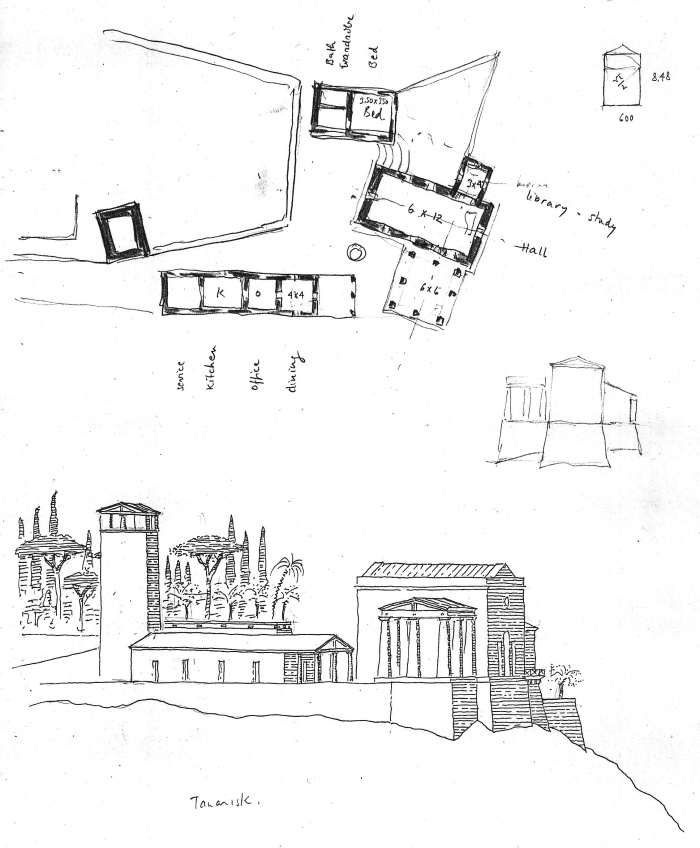
Przylądek Korfu, dom letniskowy Rothschildów dla Lorda Rothschilda na Półwyspie Stronilo na Korfu,1988.
M.M: Furniture design, along with architecture and urbanism, is a very important aspect of your work. Do you think that you have succeeded in proving that a modern man can perform his business and even his entire life within a classical environment? To what extent is it a matter of style, or perhaps an individual's lifestyle habits?
L.K: Like the majority of my modernist colleagues, I lived and worked most of my life in traditional classical and vernacular environs. I indeed remember with pain the modernist environs I had to endure, when studying at Stuttgart TH, Ulm HFG, or teaching at Yale SOA, UVA SOA, Princeton SOA. When I was invited to become a Professor at the ETH Zurich in 1976 I accepted spontaneously because I loved Zurich and Karl Moser’s ETH building. When at my first visit I was instead taken to the new suburban ETH-Hönkerberg compound, I was so appalled by the teaching premises that I resigned the prestigious post on the spot.
M.M: Humour. To be peevish and boring would certainly not help with enforcing your opinions and the life struggle that you have tasked yourself with. With an exceptional sense of humour you have succeeded, if not in converting, then at least in swaying the opinions of the army of young "contemporary" enthusiasts. Have you had this in mind since the beginning of your struggle or did this incur upon you as some sort of a reaction towards disregard or misunderstanding of your views and opinions? Also, is it possible to add that your career as a critic of modern architecture is in fact an ironic inversion of the work of one very specific modern creator?
L.K: My early professional successes were partially due to my being regularly misunderstood. I had to become explicit. A drawing famously saying more than a thousand words, I condensed my modernism critique and parallel theory of new traditional architecture and urbanism in less than 250 cartoons. The guiding lights in that undertaking were Jean-Jacques Sempé and Jacques Tati, the most acute French intellectuals of the XX C.
M.M: You grew up during a strong momentum of modern movements in architecture after World War II. What memories do you carry from that period? How did you experience modern architecture as a child and do you remember the reaction of the older fellow citizens towards the activities of rebuilding European cities?
L.K: The North of Luxembourg had been destroyed by the Battle of the Ardennes a year before I was born. Reconstructions were mostly of a traditional scale, materials and aesthetics employing traditional building crafts. Some of the most beautiful “historic” ensembles and buildings of the country rose out of the ashes in very few years following the end of WWII. As children we witnessed very consciously these extremely interesting and edifying events. These reconstructions were infinitely more attractive and speedy than the heavy industrialized reconstructions in neighbouring Lorraine which, early on, made me doubt of the proclaimed efficiency of industrialized building methods. The nearby Expo 58 in Bruxelles and the pervasive modernist propaganda, which for years filled the mass-media were in stark contrast with the collateral devastation of Bruxelles. In that same wave of modernisation my father had all the old furniture replaced by spiky modernist artefacts. We were all very proud of the new streamlined wall papers and the pointed table legs. The first great aesthetic shock struck me, when after weeks of happily awaiting the announced trouncing of the magnificent Linden alley in front of our house, which promised to unclutter our panorama of the historic city, I awoke on that sinister Monday morning, when huge pyres were consuming the last branches of the slain beloved trees. They were quickly replaced by oversized and multitudinous road lights and signage. My beautiful home address no longer quite felt like home.
Nevertheless and despite these early awakenings Le Corbusier became my first “maître à penser”. With the money of a literary school prize I bought the then 7 volumes of the Œuvre Complète.
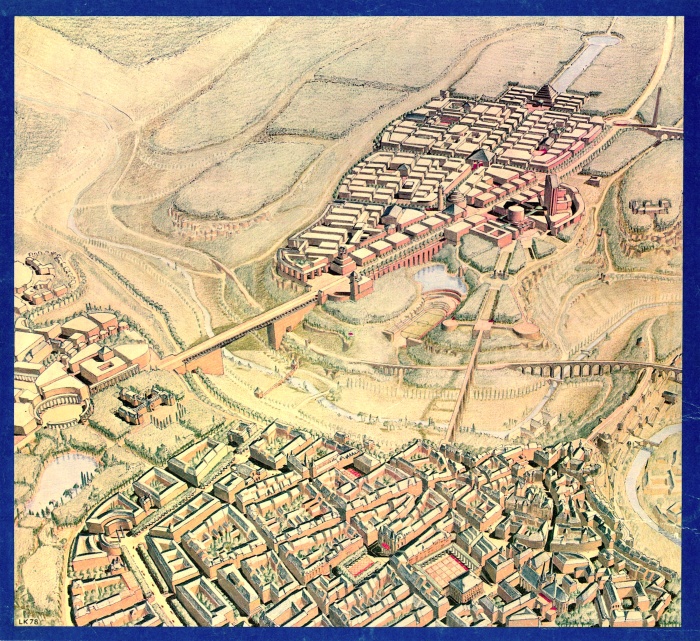
Luksemburg, Capitale De L’europe, 1978 projekt urbanizacji Parc Des Institutions Europeennes na wzniesieniu Kirchberg, zmiana podmiejskiego kampusu w dzielnicę miejską, integracja instytucji europejskich w dzielnicy miejskiej użytku mieszanego.
M.M: Do architects today, if they really want to deal with architecture, have to say goodbye to building? What are your predictions about the future of architectural practice, observing the current situation on the world's architectural scene?
L.K: In the 1970ies I became convinced that one could not as an architect be involved with the building industry without corrupting one’s ideals. I concentrated therefore for 15 years to build a coherent operative theory for a modern traditional architecture and urbanism. Now, 45 years later and having been involved in building for 30 year I confess that I was right to state that “I do not build because I am an architect-I can only make architecture because I do not build.” Considering the state of the building industry and dis-education of the designing and building professions and equally of the clientele, it is absurdly difficult to do things right when engaging in traditional designs. You need a team of people who want that product despite the materials, the politics, the legislation, the general culture which institutionally favours modernism. And yet astonishing results are achieved. They don’t capture the mass-media attention but they get welcomed by the public. A case in point are the currently completing reconstruction projects of traditional and classical buildings in Frankfurt, Dresden-Altstadt, Berlin-Schloss, Mannheim and Potsdam. Without exception these are private initiatives, backed by popular subscription. They constantly and everywhere have to overcome the dogged opposition of political, cultural and professional establishments. The latest example is the ARCH + initiative “Gegen Modernismusfeindlichkeit und Architekturpopulismus” (Against Modernism-Hostility and Architecture-Populism) signed by 70 architects. Their parallel social-media campaign, Rekonstruktions-Watch, commands to identify nationwide and denounce all attempt to reconstruct any part of Germany destroyed by allied bombs and modernist vandalism. Who is supposed to be the recipient of such denunciations is not expressed. With the self-appointed “Inquisitor”, Prof Trüby of Stuttgart University at the helm, they smear all such projects as stealthy extreme-right-wing operations making part of a revisionist rewriting of history. They brandmark as fascist and anti-democratic such breakaways from the modernist one-party reign. Paradoxically the sinister Rekonstruktions-Watch has a notable blind-spot concerning the conservative restorations and reconstructions of modernist landmarks such as the Bauhaus and Meister-Häuser in Dessau or the Weissenhof-Siedlung in Stuttgart. The undeclared objective is that the ubiquitous modernist dominance and the routine modernist rape of traditional buildings and ensembles remain unchallenged. More importantly the modernist brain-washing of the collective mind and memory via mass- media and -education must not relent. All opposition to the modernist domination must be killed in the bud. The poison seems to finally have spawned an anti-dote. The Trüby-initiative is having unintended effects. At long last, contrary opinions are voiced in the German news media.
M.M: The architectural work of Albert Speer is an almost undiscovered jewel in the architectural world, skilfully and tendentiously concealed by the moralistic worldview that looks at Speer's work through the prism of his, certainly not reputable, political career. According to Jencks, his trace is visible in the American and Western modernist architecture after the war, while Summerson calls him a silent and negative neoclassicism. Being aware of the title signed by you, we still ask of you to express your attitude towards the values and significance that Speer's architecture has and what it can represent for young generations of architects and artists?
L.K: Those who condemn Speer’s designs, because he was a war criminal, have to face a fact of life. A criminal can be a great engineer, scientist, general, banker, industrialist and equally an architect or urban planner of genius. Q.E.D. If we were to condemn all buildings and monuments of the past which were conceived by criminal regimes, there would be little to admire of past architectures. In fact, good architecture and urbanism by nature transcend the narrow political or cultural goals of the regimes which realise them. You may dislike Napoleon III politics and fully enjoy living in the modern Paris which he invented. Democratic society has less problems to inhabit comfortably those buildings and spaces than it does to live in ugly Berlin, imperial New York, delirious Dubai or soul-killing suburban mega sprawl. I am certain that had Speer’s Berlin plan been realised, it could have become happily inhabited and adapted by a modern democratic society. It would have become the reference for modern sustainable and attractive metropoles. There quite simply doesn’t exist a modernist alternative metropolitan model to this day.
The interview with Leon Krier was published on January 13, 2019 in the TRISTOSTROJKA Magazine
Questions and description: Mirza Mehaković
Drawing: Ignacy Czwartos
English translation: Dino Jozić
Polish translation: Antoni Śmist


